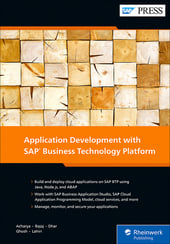In this video, explore the different SAP BTP development environments available to developers.
Transcript:
In this video, we’ll introduce you to the five SAP BTP development environments.
The serverless option is primarily used for doing short proof of concept kinds of development, which can then be scaled down to zero when not in use or scaled up, as required. This option is supported by SAP BTP, Kyma runtime, which we’ll talk about shortly.
Cloud Foundry has become the industry-standard, open-source, cloud-based platform that can be deployed on any infrastructure, owned in-house or hosted on the cloud, called infrastructure as a service. Commercial Cloud Foundry providers can provide PaaSs like SAP BTP or IBM Cloud Foundry, among others. Since 2014, SAP has partnered with other infrastructure providers that have joined the Cloud Foundry Foundation (https://www.cloudfoundry.org/foundation/) so that these providers can deploy Cloud Foundry for any compliant infrastructure.
Available since May 2017, Cloud Foundry in simple terms can be described as an operating system for a cloud platform that provides a standardization layer.
The Cloud Foundry platform enables you to deploy any app or service within minutes and makes these apps or services scalable, depending on their usage. Its layer of standardization has in fact become the de facto standard for cloud platforms. The Cloud Foundry architecture offers container-based isolation between the various parts of your application, including, for instance, SAP HANA deployment infrastructure containers or an app container in the application layer. Multiple app containers can separate microservices, for instance, in different languages.
As shown, note how Cloud Foundry has made the SAP BTP architecture quite open.
SAP BTP, ABAP environment, supports the latest version of ABAP. While the development must be performed using the ABAP perspective in the Eclipse IDE currently, the deployment of the application occurs in the ABAP server on SAP BTP. A set of development toolsets are part of the Eclipse IDE. This ABAP code as a service, is operated by SAP.
Thus, SAP BTP, ABAP environment, has two components.
For some scenarios that are tightly coupled to an existing SAP S/4HANA model, the extension becomes difficult since it is not loosely coupled. For this scenario, the embedded Steampunk solution and developer extensibility have been introduced. This option is currently available in SAP S4HANA Cloud and is planned for SAP S/4HANA.
The architecture shows how the ABAP instance is running on a space connected to an SAP HANA database. Using the SAP Connectivity service, you can connect with other cloud systems like SAP S/4HANA Cloud, SAP Ariba, or any cloud APIs. Leveraging a cloud connector, you can connect any system in your business network including those behind a corporate firewall, whichever is supported by the cloud connector.
Also, an ABAP application can use any SAP BTP service. Within the SAP BTP cockpit, you can configure the launchpad for system admin activities using SAP Fiori apps. SAP Business Application Studio can be used to build SAP Fiori apps as well. The development is performed through ABAP Development Tools available on the Eclipse IDE, and developments can be stored in Git repositories. Different use cases would leverage different parts of this architecture. This figure shows the Eclipse IDE for developing custom code.
As of late 2022, developer extensibility on SAP S/4HANA Cloud for scenarios that cannot be achieved using side-by-side extensions is possible with the embedded Steampunk on the stack.
SAP initiated the development of an open-stack project called Kyma, which uses Kubernetes clusters for container deployment, along with a set of other related activities for maintaining and scaling applications. These additional activities are now transparent to users using Kyma-managed services in the SAP BTP platform. With SAP BTP, Kyma runtime, you can create your own applications or extend SAP’s cloud applications.
Both Kyma and Kubernetes are operated by SAP, and thus, all patches and software upgrades are handled by SAP and are supported according to SAP BTP service level agreements (SLAs).
SAP acquired the company AppGyver as an environment for low-code and no-code development, using it as the base of their new solution SAP Build, and this solution is typically used for quick development and prototyping, especially for mobile applications that can then be deployed on any platform for any device. Other tools that enable low-code and no-code approaches for the SAP Process Automation suite include SAP Workflow Management and SAP Intelligent Robotic Process Automation.
SAP Build offers some powerful features that enable development, such as the following.
This UI helps you generate the code by simply selecting from a large library of UI components that can then be modified without any coding. Themes are available to help you build UIs even more quickly.
Business logic also can be built up through visual aids, leveraging 400+ formula functions, simply by dragging and dropping logical components, without any coding.
This environment provides the ability to integrate APIs in no time and even to integrate with REST APIs through the REST Integration wizard. From a UI perspective, SAP Fiori-based themes are available to help you create SAP Fiori-like UIs, although without SAPUI5 controls. You can even extend SAP’s functionalities like SAP Sales Cloud or SAP Service Cloud through a UI built in SAP Build.
This video provided an overview of the available SAP BTP development environments, and now you’re ready to get started coding!
This post was originally published 4/2023.



Comments